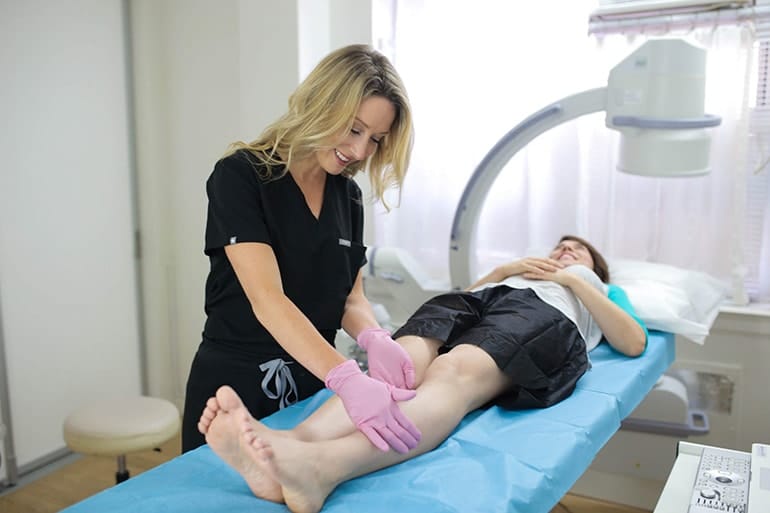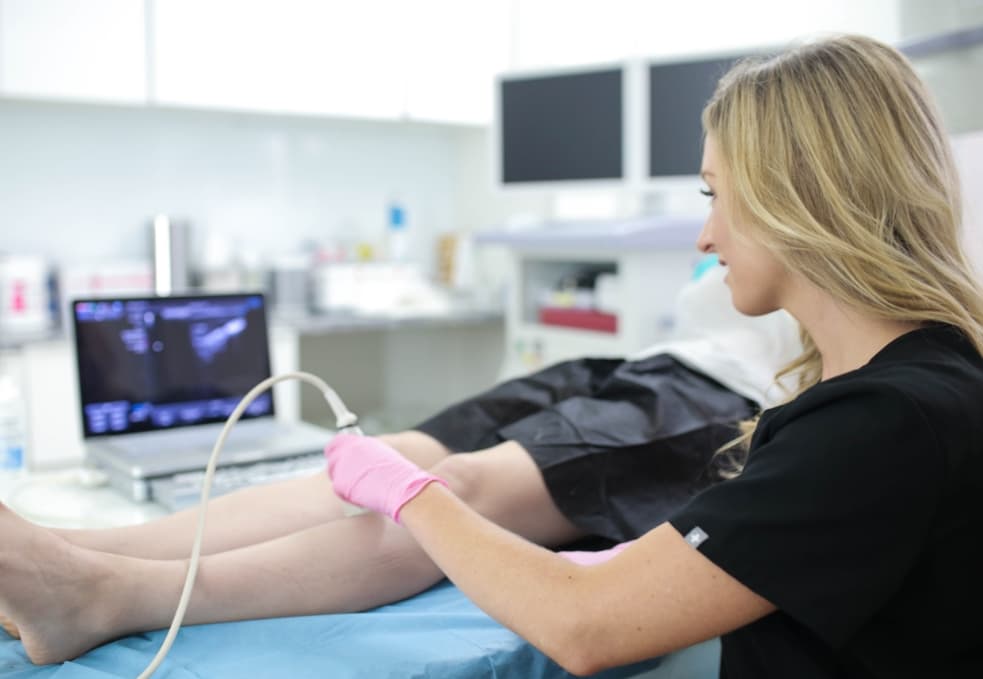Are you one of the millions of Americans who suffer from vein disease? If you’ve noticed unusual changes in your lower extremity veins, it’s essential to understand the stages of varicose vein disease. Varicose veins are damaged blood vessels that protrude out of the skin’s surface, often resembling a mass of twisted, knotted, and gnarled ropes or tree branches. Varicose veins are usually caused by chronic venous insufficiency, a dangerous medical condition wherein blood accumulates in the leg veins. If you notice spider veins or varicose veins, you must consult a board-certified vein doctor for prompt diagnosis and treatment.
At Maryland Vein Center, we specialize in minimally invasive treatments for varicose and spider veins. Our vein center is conveniently located in Bethesda, Maryland, just outside of Washington, DC. If you notice the signs and symptoms of varicose veins and vein disease, please don’t hesitate to schedule a consultation today. Below, we provide a complete overview of the various varicose vein stages, including their accompanying symptoms.
Stage 1: Early Warning Signs
In the initial stages of varicose vein disease, many individuals experience subtle but persistent symptoms that often go unnoticed. These early warning signs may include:
- Vein Discoloration: You may notice that the veins in your lower extremities, especially the legs, appear darker or more prominent than usual.
- Leg Fatigue: You might feel a sense of tiredness or heaviness in your legs after prolonged periods of standing or sitting.
- Itching and Burning: Some report itching or burning sensations along the affected veins.
- Swelling: Mild swelling, especially around the ankles, can occur.
- Restlessness: Restless leg syndrome, a persistent urge to move your legs, may also appear. In this case, you have an insatiable urge to move and shake your legs.
Recognizing these early signs is crucial, as timely intervention can prevent the progression of vein disease to more severe stages. These early symptoms are often misattributed to aging or exhaustion. However, if you notice that these symptoms worsen at the end of the day or after long periods of sitting or standing still, there’s a strong chance you’re dealing with varicose veins. Please schedule a consultation if you experience any of these symptoms.

Stage 2: Vein Enlargement and Spider Veins
As vein disease progresses, the symptoms become more pronounced. Stage 2 is characterized by the following developments:
- Vein Enlargement: Your veins become noticeably larger and may appear twisted or knotted beneath the surface of your skin. Some people describe varicose veins as enlarged, bulging, twisted, rope-like veins that protrude from the skin’s surface.
- Spider Veins: In addition to varicose veins, you may develop spider veins, which are smaller, web-like clusters of dilated blood vessels. You may notice a reddish, bluish, or purplish cluster of web-like blood vessels on your lower extremities.
- Leg Pain: You may begin to experience aching or discomfort in your legs, particularly after prolonged periods of standing or sitting.
- Skin Changes: Skin around the affected veins may become discolored, dry, or flaky. This happens because varicose veins are caused by blood pooling in your leg veins, which also impedes proper blood flow. And without proper blood flow, your skin looks discolored.
It’s essential to remember that spider veins and varicose veins are not just cosmetic concerns. They often indicate underlying venous insufficiency, a condition where the valves in the veins no longer function correctly. As such, if you notice these advanced signs and symptoms of varicose veins, please visit your nearest vein center in Maryland for a consultation and prompt treatment.
Stage 3: Chronic Venous Insufficiency (CVI)
If varicose vein disease continues to progress unchecked, it can lead to the development of chronic venous insufficiency (CVI). Varicose veins and CVI have a two-way relationship — one can influence the other. In some cases, varicose veins are caused by chronic venous insufficiency, and in other cases, they can lead to venous insufficiency. Before we discuss the possible symptoms of this stage, you may wonder, “what is chronic venous insufficiency?”
Chronic venous insufficiency (CVI) is a condition wherein the valves in the leg veins (normally responsible for ensuring blood flows toward the heart) fail to function correctly, causing blood to flow backward and pool in the lower extremities. CVI is a serious medical issue that demands prompt attention and specialized care.
At this stage, symptoms become more severe, and the risk of complications increases:
- Leg Ulcers: CVI can cause open sores or ulcers to form on the skin, especially near the ankles. This happens because CVI leads to poor blood circulation in the legs, so the wounds in your legs don’t heal properly.
- Severe Leg Pain: You may experience intense and persistent pain in your legs, hindering your ability to perform daily activities.
- Skin Changes: Skin around the affected area may become leathery or hardened.
- Swollen Ankles: Ankle swelling becomes more pronounced and persistent.
If you suspect you have reached this stage, please seek medical attention promptly. Maryland Vein Center specializes in diagnosing and treating CVI to improve your overall well-being.
Stage 4: Advanced Venous Disease
In advanced stages of varicose vein disease, the condition can lead to more severe complications and may require more aggressive treatments. Some key indicators of advanced venous disease include:
- Deep Vein Thrombosis (DVT): This is a potentially life-threatening condition where a blood clot forms in the deep veins of the leg. Symptoms include severe pain, swelling, and warmth in the affected leg. The blood clot can also break away and travel to the lungs, leading to a potentially fatal condition known as pulmonary embolism. Treatment is essential.
- Skin Infections: Open sores and ulcers become prone to infection, leading to cellulitis or other skin infections. As such, you must seek treatment without delay.
- Venous Stasis Dermatitis: The skin may develop a brownish discoloration and become increasingly fragile.
- Profuse Bleeding: Weakened vein walls can rupture, causing profuse bleeding, which can be challenging to control and necessitates a visit to the emergency room. As the varicose veins expand and dilate, their vein walls weaken, so even slight pressure can lead to varicose veins bursting.
If you notice the signs and symptoms of advanced venous disease, please visit your nearest vein center in Maryland without delay.
Seeking Treatment at Maryland Vein Center
At Maryland Vein Center, we are committed to providing the highest quality care for patients with varicose vein disease at all stages. Our board-certified vein doctors specialize in minimally invasive treatments that offer excellent results and minimal downtime. Some of the advanced treatments we offer include:
- Sclerotherapy: A procedure that involves injecting a solution into the affected veins to close them off and reroute blood flow. This treatment is suitable for spider veins and small varicose veins. It’s mostly a cosmetic procedure — it can’t treat underlying vein disease.
- Endovenous Laser Ablation (EVLA): A laser is used to seal off the diseased vein, redirecting blood flow to healthier veins. The vein doctor inserts a catheter into the diseased vein and channels laser energy to collapse its walls. The damaged vein eventually gets reabsorbed by the body. EVLA treats varicose veins and underlying vein disease.
- Radiofrequency Ablation (RFA): This technique uses radiofrequency energy to close off the problematic vein. Similar to an EVLA, the vein doctor inserts a catheter through a small incision to burn the damaged vein, restoring optimal blood flow to the heart. This procedure also treats varicose veins and underlying vein disease.
- VenaSeal: A specialized medical adhesive is used to seal the diseased vein shut. The vein doctor inserts a catheter and injects the vein glue to seal the diseased vein’s walls, turning it into a hardened tissue eventually absorbed by the body. This procedure treats chronic venous insufficiency and minimizes the risk of nerve injury.
- Ambulatory Phlebectomy: Minimally invasive surgery is performed to remove superficial varicose veins. The vein doctor makes small incisions on the skin close to the varicose veins and uses specialized hooks to extract them, providing immediate cosmetic improvements.
Our treatment approach is personalized, starting with a thorough evaluation that includes duplex ultrasound to diagnose the root cause of your vein issues. We also offer free insurance verification to ensure you have a clear understanding of your coverage.
Take Prompt Action Against Varicose Vein Disease
Understanding the stages of varicose vein disease is the first step in taking control of your vascular health. Whether you’re experiencing mild discomfort or severe symptoms, Maryland Vein Center is here to help. Contact us today for a consultation and let us create a personalized treatment plan to address your specific needs. You can find our vein center in Maryland at 10215 Fernwood Rd, Suite 301, Bethesda — schedule an appointment today.





